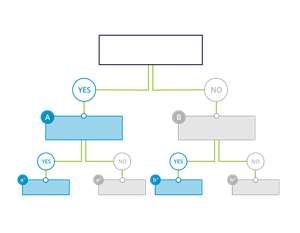By
Chris Rall
|
Date Published: June 10, 2019 - Last Updated September 08, 2020
|
Comments
Organizing information is one of the most challenging tasks of the modern
age, making it useful even more so. Customer service agents now find
themselves handling both more information and channels than ever before. At
the same time,
this complexity makes consistency and accuracy difficult. But there’s a
hidden hero to the rescue! Decision trees cut through the complexity and
enable you to deliver quick and consistent customer support. They can make
onboarding and training faster and even be integrated into other channels
such as chatbots or virtual assistants like Alexa.

What Are Decision Trees? (and what they’re not)
Decision trees are support tools that use a flowchart or tree like model to
visualize service and contact center processes. Since customer service is a
form of personal troubleshooting with a customer, it is ideally suited to
creating step-by-step guides for resolving customer issues. Decision trees
depict this in chart form starting with a question node and then branching
off into paths for yes and no that are followed based on the customer’s
answer. This simple logic becomes a powerful tool that can be used to power
many service processes and better enable your customer service
professionals.
Consistency is a prerequisite for improving your customer service.
In the past, decision trees were static charts or required coding skills.
Today, they are interactive and guide the agent and customer step-by-step.
This means agents can skip memorizing dozens or even hundreds of problems
and solutions and won’t have to read through a wall of text in a Word
document.
Why Decision Trees are Important in Customer Service
Consistency is a prerequisite for improving your customer service! By
simplifying complex processes and reducing the amount of information agents
are required to remember, they eliminate challenges such as:
- Difficulty finding information
- Long search times
- Agents sticking too closely to scripts
- Long onboarding and training times
- Inconsistent performance among agents or contact centers
When combined with the right knowledge management, they can be a real game
changer in agents’ everyday work.
Using Decision Trees for Chatbots, Self-Service & More
Would you like to ensure that the same service inquiry is solved the same
way in every channel in every interaction with the customer? Decision
trees, particularly when integrated into your knowledge management platform
can power multiple services and channels at the same time. That makes them
a real force multiplier. Here’s where you can employ them:
1. Guided Dialogues for Agents
Guided dialogues are a kind of one-sided chat that walks an agent
step-by-step through an inquiry. It provides the question to be asked and
prompts the agent to enter the customer’s answer. The system tracks the
entire inquiry process providing an overview of the case and the next step
to take. This helps make even new employees as efficient as experienced
agents and the hand-off from one department to another one is more
transparent, because they can refer to the
same previously answered questions.

2. Customer Service Chatbots
Decision trees are also ideally suited for managing chatbots. In
low-context situations involving simple transactions or inquiries, they can
ensure chatbots are useful and consistent.
Example use cases for chatbots include:
- Webinar registration
- Troubleshooting a printer problem
- Choosing a mobile phone plan
- Get an insurance quote
- Order pizza
In addition, the same decision tree can be used for both internal and
external users which helps to reduce the editorial effort and raise
transparency within all channels.
3. Voice Assistants like Alexa
Companies interested in using voice assistants like Alexa, Siri and Google
Assistant for customer service are in luck. Since the use cases are like
chatbots, the voice skill can act as an audio interface for an existing
chatbot. One insurance company for example,
did exactly that
enabling customers to get policy information and soon make transactions via
Alexa (powered by a chatbot in the background).
4. Self-Service Solutions
Starting with the initial problem, decision trees enable customers to
troubleshoot interactively and be guided step-by-step through the process.
This is both easier and preferable from a user’s perspective to navigating
a long F.A.Q. or downloading help documents. Successful self-service
requires both up-to-date information and a solid process underlying it.
Decision trees integrated within your knowledge base provide both.
How Decision Trees Impact Your KPIs

With so much off their plate, agents can focus more on helping customers
and less on searching and remembering things. The effects of this can be
seen on the department level in higher First Contact Resolution rates
(FCR), reduced Average Handling Time (AHT) and overall better customer
experiences which impacts both NPS and CSAT. Decision trees contribute to:
-
Increased efficiency
-
Consistent performance
-
Better idea of handling time for inquiries
-
Higher agent satisfaction
-
Higher FCR & fewer transferred calls
-
Higher CSAT and NPS
Hire Agents to be People not to Memorize Information
Customer service representatives excel at dealing with people and having
the experience and emotional intelligence to interact with a wide range of
personality types and problems in many situations. We don’t hire them to
memorize information or be search ninjas. That’s why empowering agents with
the tools that let them focus on what they’re best at is a critical part of
creating a consistently excellent customer experience.
Learn more about the power of
decision trees in your knowledge
base
.